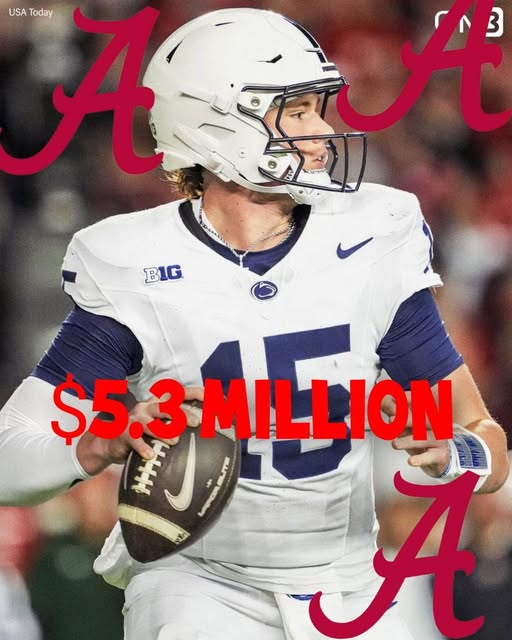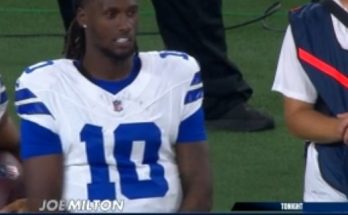In a move that has sent shockwaves through the college football community, one of the nation’s most coveted five-star quarterbacks has dramatically reshaped the recruiting landscape by turning down an astonishing \$5.4 million offer, decommitting from Penn State, and flipping his commitment to Alabama over high-profile programs like Notre Dame and Florida State. This unexpected decision has fans, analysts, and coaches scrambling to understand the motives behind this seismic shift and what it means for the future of college football.
For years, this quarterback has been widely regarded as a generational talent—a player whose skill set, leadership qualities, and football IQ positioned him as the clear frontrunner for the highest honors in the sport. His journey to this point was marked by consistent dominance at every level, from high school to national camps, and a recruitment process that attracted intense interest from virtually every top program in the country. When he initially committed to Penn State, it was hailed as a massive victory for the Nittany Lions, signaling a potential renaissance for a program looking to climb back into the national elite.
However, the landscape shifted dramatically with the revelation of a \$5.4 million offer, an unprecedented figure in the context of college athletics recruiting—although the nature of this offer remains under close scrutiny due to NCAA regulations and the ongoing debates around athlete compensation and Name, Image, and Likeness (NIL) deals. Despite the staggering amount on the table, the quarterback chose to walk away from it, a decision that stunned many observers and sparked widespread speculation about his true priorities and vision for his future.
This decommitment from Penn State was not merely a withdrawal; it was a statement. The quarterback’s subsequent decision to flip his commitment to Alabama over the likes of Notre Dame and Florida State Seminole underscored a strategic and deeply personal choice. Alabama, under the legendary coach Nick Saban, has built a reputation as the gold standard for college football excellence. The Crimson Tide’s program is synonymous with national championships, a pipeline to the NFL, and an environment designed to develop elite talent. This quarterback’s choice to join Alabama signals a desire to be part of that winning culture and to position himself for maximum exposure and growth at the highest level of the college game.
Notre Dame and Florida State, two storied programs with rich traditions of their own, were also vying fiercely for the quarterback’s commitment. Notre Dame, with its national brand and independent schedule, offers a unique platform that blends academic prestige with athletic competition. Florida State Seminole, meanwhile, represents a chance to be the centerpiece of a program looking to reclaim its dominance in the Atlantic Coast Conference and nationally. Both schools made compelling cases, but ultimately, the quarterback’s decision to join Alabama highlights the powerful draw of a program with a proven track record of success in developing NFL-ready quarterbacks.
What makes this story even more compelling is the quarterback’s refusal of the \$5.4 million offer. In an era where NIL deals and athlete compensation have become significant factors in recruitment, rejecting such a large sum raises important questions about the player’s values and long-term aspirations. It suggests a focus beyond immediate financial gain, emphasizing personal growth, team success, and the pursuit of championships. It also reflects the complex and evolving nature of college football recruitment, where players weigh a variety of factors—coaching, development, culture, exposure, and personal fit—alongside financial incentives.
The reaction from the Penn State community has been one of shock and disappointment. The program had invested significant resources and emotional energy into securing this commitment, viewing the quarterback as the linchpin of their future success. His departure leaves a void that will be difficult to fill and forces the coaching staff to reevaluate their recruiting strategy moving forward. Yet, even amid this setback, Penn State remains a strong program with a passionate fan base, and they will undoubtedly continue to compete at a high level.
Alabama’s fan base, conversely, is exhilarated by the news. Securing a five-star quarterback of this caliber is a statement of intent for the Crimson Tide’s next era of dominance. With this addition, Alabama not only strengthens its roster but also sends a message to other top recruits that it remains the destination for elite talent. This move further cements Alabama’s position at the pinnacle of college football recruiting, reinforcing the program’s reputation as the place where the best players want to be.
For Notre Dame and Florida State, the loss is a tough pill to swallow but not an insurmountable obstacle. Both programs have a history of attracting top-tier talent and are likely to intensify their recruiting efforts elsewhere. This development underscores the fierce competition for elite players in the modern college football landscape and the thin margins that separate success from disappointment in the recruitment game.
From a broader perspective, this saga exemplifies the shifting dynamics of college football recruiting in the 2020s. The increasing influence of NIL deals, social media presence, player empowerment, and transparency in recruitment has transformed how athletes make decisions. Gone are the days when programs could rely solely on tradition, facilities, and coaching reputation. Today’s athletes are entrepreneurs, brand managers, and strategists, considering a complex matrix of factors to optimize their careers both on and off the field.
The quarterback’s choice to turn down a \$5.4 million offer and opt for a program with a storied legacy over immediate financial gain might well become a defining moment in this era. It could inspire other athletes to prioritize legacy, development, and team culture over monetary rewards, or it could signal a rare exception in an increasingly commercialized sport. Either way, it will be studied, debated, and analyzed for years to come.
In addition to the immediate ramifications on the programs involved, this decision also shines a spotlight on the evolving relationship between college sports and athlete compensation. As more players leverage their NIL rights and negotiate lucrative deals, the boundaries between amateurism and professionalism blur. The NCAA and conferences are continually adapting policies to accommodate these changes, but the debate over fairness, equity, and the spirit of college athletics remains heated. This quarterback’s story adds a human element to this complex issue, reminding fans and stakeholders that behind every decision are individual hopes, dreams, and values.
Ultimately, this five-star quarterback’s shocking decommitment from Penn State and subsequent commitment to Alabama over Notre Dame and Florida State is more than just a recruiting headline. It is a reflection of the modern college football landscape—a world where talent, money, tradition, and personal ambition intersect in unpredictable ways. It is a story about courage, vision, and the pursuit of excellence on the grandest stage.
As the college football season unfolds and the recruiting cycle progresses, all eyes will remain on this quarterback, eager to see how his decision shapes not only his career but the fortunes of the programs involved. Will Alabama’s gamble pay off with championships and NFL success? Will Penn State recover from this loss and continue its ascent? Can Notre Dame and Florida State regroup and find their next star? These questions add a thrilling narrative layer to the sport’s ongoing drama.
In the end, the quarterback’s bold move serves as a reminder of why college football remains one of the most compelling and unpredictable sports in America. It is a game of passion, dreams, and decisions that can change the course of history in an instant. And this summer’s recruiting bombshell is a perfect example of that enduring excitement.



